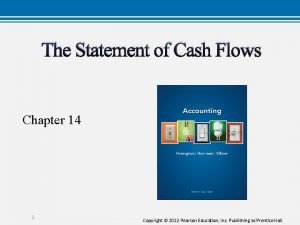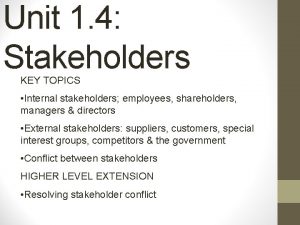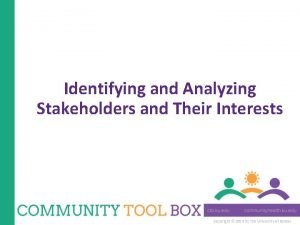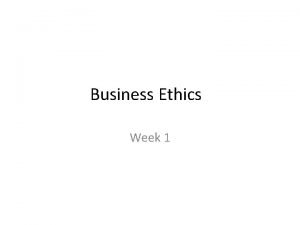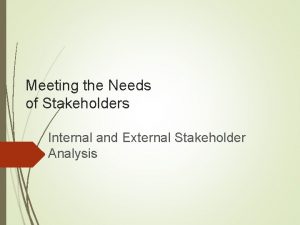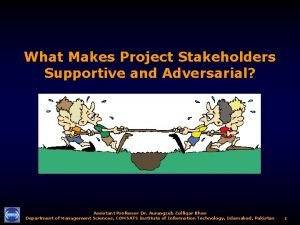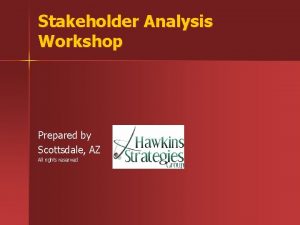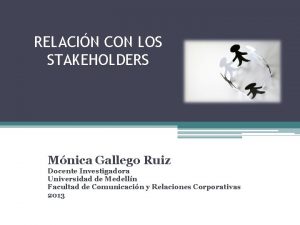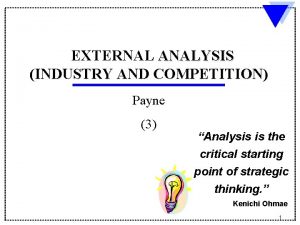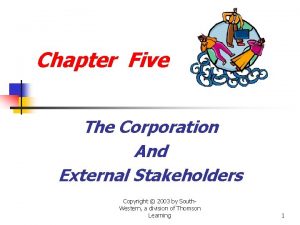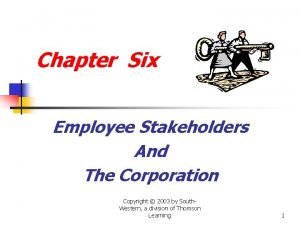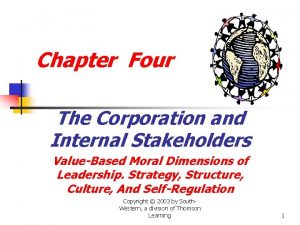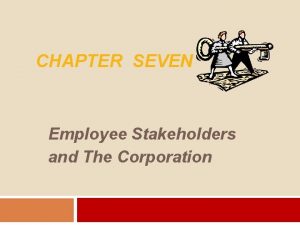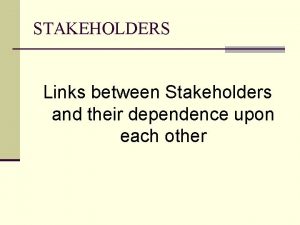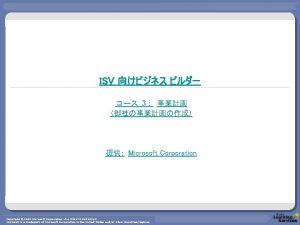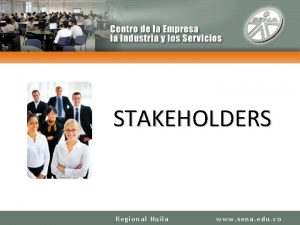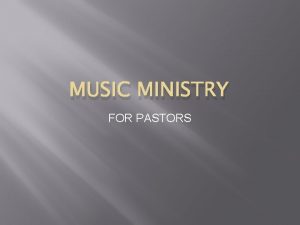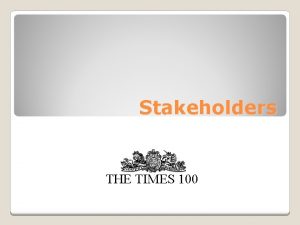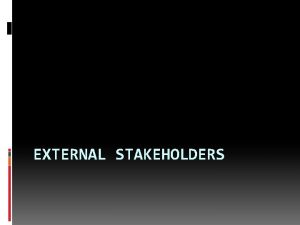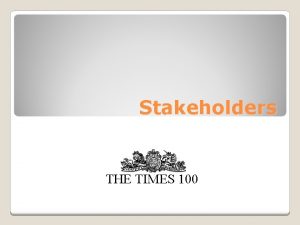Chapter 1 The Corporation and Its Stakeholders Copyright





























- Slides: 29

Chapter 1 The Corporation and Its Stakeholders Copyright © 2017 Mc. Graw-Hill Education. All rights reserved. No reproduction or distribution without the prior written consent of Mc. Graw-Hill Education.

Business and society together form an interactive social system § Business: the term business refers to any organization that is engaged in making a product or providing a service for profit. § Society: Human beings and the social structures they collectively create. § In a more specific sense, the term is used to refer to segments of humankind, such as members of a particular community, nation, or interest group. Copyright © 2017 Mc. Graw-Hill Education. All rights reserved. No reproduction or distribution without the prior written consent of Mc. Graw-Hill Education. 1 -2

Business and society together form an interactive social system Figure 1. 1 Business and Society: An Interactive System Copyright © 2017 Mc. Graw-Hill Education. All rights reserved. No reproduction or distribution without the prior written consent of Mc. Graw-Hill Education. 1 -3

Business and society together form an interactive social system General Systems Theory (GST): § Organisms do not exist in isolation but can only be understood in relationship to their surroundings. § Businesses are embedded in a broader social environment with which they constantly interact. § They are influenced by customers, governments, competitors, media, communities and many more factors. § Business must adapt to changes in the environment to survive. General Systems theory helps us understand how business and society form an Interactive Social System. Each needs the other and influences the other. Copyright © 2017 Mc. Graw-Hill Education. All rights reserved. No reproduction or distribution without the prior written consent of Mc. Graw-Hill Education. 1 -4

Stakeholders VS Stockholders (Shareholders) § Stakeholders: are persons or groups that affect, or are affected by, a firm’s decisions, policies, and operations. § Stakeholder is NOT the same as stockholder (or shareholders). § Stockholders: are the owners of the firm/business/corporation. § Stockholders represent one of several kinds of stakeholders. Copyright © 2017 Mc. Graw-Hill Education. All rights reserved. No reproduction or distribution without the prior written consent of Mc. Graw-Hill Education. 1 -5

Purpose of Business § What is the purpose of the corporation? § To whom, or what, should be the firm responsible for? Copyright © 2017 Mc. Graw-Hill Education. All rights reserved. No reproduction or distribution without the prior written consent of Mc. Graw-Hill Education. 1 -6

Ownership Theory of the Firm (also called property or finance theory) § Sees the firm as property of owners (shareholders). § Based on the ownership theory, the purpose of the firm is to maximize its long-term market value and money for its shareholders. This means that the goal of the company is to make the most money it can for the shareholders that own the company. § Owners’ interests take precedence over interests of others. Copyright © 2017 Mc. Graw-Hill Education. All rights reserved. No reproduction or distribution without the prior written consent of Mc. Graw-Hill Education. 1 -7

Stakeholder Theory of the Firm § Based on the stakeholder theory, corporations serve a broad public purpose: to create value for society. § Profit is necessary for survival but other values drive the firm’s purpose. So believing in the stakeholder theory does not mean that you do not need profits. § Corporations have multiple obligations and need to consider all stakeholders. § Examples include: 1. Professional development for their employees 2. Producing high quality products to satisfy the customers 3. Supporting an environmental/societal cause and allocate a specific percentage out of the company’s profits to support it. Copyright © 2017 Mc. Graw-Hill Education. All rights reserved. No reproduction or distribution without the prior written consent of Mc. Graw-Hill Education. 1 -8

Ownership theory and stakeholder theory define the purpose of business differently Ownership Theory Purpose üOwner’s needs and wants üIncrease share value Stakeholder Theory Purpose üStakeholders’ Needs and Wants Copyright © 2017 Mc. Graw-Hill Education. All rights reserved. No reproduction or distribution without the prior written consent of Mc. Graw-Hill Education.

The three arguments that support the stakeholder theory § The descriptive argument is that the stakeholder theory is simply a more realistic description of how companies work. § The instrumental argument is that the stakeholder theory is more effective (financially) as a corporate strategy, which is supported by many studies. § The normative argument is that the stakeholder theory is simply the right thing to do. Copyright © 2017 Mc. Graw-Hill Education. All rights reserved. No reproduction or distribution without the prior written consent of Mc. Graw-Hill Education.

Three arguments in support of the stakeholder theory of the firm Descriptive Normative Instrumental Copyright © 2017 Mc. Graw-Hill Education. All rights reserved. No reproduction or distribution without the prior written consent of Mc. Graw-Hill Education. 1 -11

Stakeholders § Stakeholders are persons or groups that affect, or are affected by, a firm’s decisions, policies, and operations. § A stake is an interest in–or claim on–a business. § Stockholders represent one of several kinds of stakeholders. § Examples of stakeholders: 1. 2. 3. 4. 5. 6. 7. Customers Employees Stockholders Media Governments Social and environmental activists Nonprofit organizations Copyright © 2017 Mc. Graw-Hill Education. All rights reserved. No reproduction or distribution without the prior written consent of Mc. Graw-Hill Education. 1 -12

Two Kinds of Stakeholders: Market and Nonmarket § Market stakeholders They engage in economic transactions with the company as it carries out its primary purpose of providing society with goods and services. Examples: Shareholders, suppliers, employees, creditors, customers. Shareholders § Nonmarket stakeholders People or groups who—although they do not engage in direct economic exchange with the firm—are affected by or can affect its actions. Examples: Community, government, business support groups, activists, media, nonprofits, the general public Community Government Competitors Environment Copyright © 2017 Mc. Graw-Hill Education. All rights reserved. No reproduction or distribution without the prior written consent of Mc. Graw-Hill Education. 1 -13

Controversial Cases § Governments are typically nonmarket stakeholders. However, governments sometimes are owners of the business (investors). Plus, governments sometimes buy from the firm. These actions make them market stakeholders. § Media is typically a nonmarket stakeholder. However, firms buy advertisements sometimes, which is a market transaction. Copyright © 2017 Mc. Graw-Hill Education. All rights reserved. No reproduction or distribution without the prior written consent of Mc. Graw-Hill Education.

Internal VS External Stakeholders § Internal Stakeholders are those who are employed by the company and to the everyday operation of the firm. § Examples: employees and managers. § External Stakeholders are those who are not directly employed by the firm, even if they have important transactions with the firm. § Examples: Customers, Stockholders, Governments, Media, Communities, Creditors, and Suppliers. Copyright © 2017 Mc. Graw-Hill Education. All rights reserved. No reproduction or distribution without the prior written consent of Mc. Graw-Hill Education.

Internal stakeholders are employed by the firm external stakeholders are not Suppliers Employees Society Company Managers Government Creditors Shareholders Customers Internal stakeholders work “inside” the firm and contribute their effort and skill to everyday operations. External stakeholders may have important transactions with the firm, but are not part of the firm. Copyright © 2017 Mc. Graw-Hill Education. All rights reserved. No reproduction or distribution without the prior written consent of Mc. Graw-Hill Education. 1 -16

Stakeholder Analysis § Stakeholder analysis: is to identify relevant stakeholders and to understand both their interests and the power they may have. § Focal Organization: the organization that is conducting the stakeholder analysis. In other words, it is the organization from whose perspective the analysis is conducted. Copyright © 2017 Mc. Graw-Hill Education. All rights reserved. No reproduction or distribution without the prior written consent of Mc. Graw-Hill Education.

The four key questions of Stakeholder analysis Figure 1. 3 Copyright © 2017 Mc. Graw-Hill Education. All rights reserved. No reproduction or distribution without the prior written consent of Mc. Graw-Hill Education. 1 -18

A Firm and Stakeholders Figure 1. 2 Copyright © 2017 Mc. Graw-Hill Education. All rights reserved. No reproduction or distribution without the prior written consent of Mc. Graw-Hill Education. 1 -19

Stakeholder Analysis Question 1 Who are the relevant stakeholders? § Identify and map relevant stakeholders. § Draw market and nonmarket stakeholder maps. § Recognize not all groups/stakeholders are relevant to every situation. Example: § A certain stakeholder may not be relevant to a particular decision/action. Some businesses sell directly to the public or online, and will not have retailers. Copyright © 2017 Mc. Graw-Hill Education. All rights reserved. No reproduction or distribution without the prior written consent of Mc. Graw-Hill Education. 1 -20

Stakeholder Analysis Question 2 What are interests of each stakeholder? § Stakeholder interests: are the concerns, wants, and demands that they want/expect from the firm. They are essentially the nature of each group’s stake. § The main questions to ask here are: § What are the groups’ concerns? § What does the group want/expect from their relationship with the firm? Examples: § Shareholders have an ownership interest; they expect to receive dividends and capital appreciation. § Customers are interested in gaining fair value and quality in goods and services they purchase. § Public interest groups advance broad social interests. Copyright © 2017 Mc. Graw-Hill Education. All rights reserved. No reproduction or distribution without the prior written consent of Mc. Graw-Hill Education. 1 -21

Stakeholder Analysis Question 3 What is the power of each stakeholder? § Stakeholder power: is the ability of a group to use resources to make an event happen or to secure a desired outcome. § There are 5 types of stakeholder power: § Voting power: stockholder can vote on company issues. § Economic power: customers can stop buying from the company if they do not like the quality of your service/products. § Political power: governments exercise political power through regulations. § Legal power: any stakeholder can file a suite against the company for damages that the firm caused. § Informational power: stakeholders might have access to valuable data. Copyright © 2017 Mc. Graw-Hill Education. All rights reserved. No reproduction or distribution without the prior written consent of Mc. Graw-Hill Education. 1 -22

Stakeholder Analysis Question 4 How are stakeholder coalitions likely to form? § Stakeholder groups often have common interests and will form temporary alliances to pursue these common interests. § Coalitions are very dynamic (can change at any time); Coalitions are not static. § Coalitions are increasing international. § Internet has enabled coalitions to form quickly, across political boundaries. Copyright © 2017 Mc. Graw-Hill Education. All rights reserved. No reproduction or distribution without the prior written consent of Mc. Graw-Hill Education. 1 -23

Stakeholder Salience and Mapping § Salience – stands out from a background, is seen as important, or draws attention. § Stakeholders stand out (i. e. , are salient) to managers when they have power, legitimacy, and urgency. § Legitimacy refers to if the stakeholder's actions are seen as appropriate by the society. § Urgency refers to how urgent the action is supposed to be for a stakeholder’s claim § Managers can use the salience concept to develop a stakeholder map – a graphical representation of the relationship of stakeholder salience to a particular issue. § A stakeholder map is a useful tool, because it enables managers to see quickly how stakeholders feel about an issue. Copyright © 2017 Mc. Graw-Hill Education. All rights reserved. No reproduction or distribution without the prior written consent of Mc. Graw-Hill Education. 1 -24

Stakeholder Map Figure 1. 4 The graph below is about whether the company is supposed to close an underperforming factory or not? Copyright © 2017 Mc. Graw-Hill Education. All rights reserved. No reproduction or distribution without the prior written consent of Mc. Graw-Hill Education. 1 -25

The Corporation’s Boundary-Spanning Departments § Boundary-spanning departments (shown graphically in the following slide): departments or offices within an organization that reach across the dividing line that separates the company from groups and people in society. § Examples of boundary-spanning departments: 1. Shareholders’/investors’ relations. 2. Public relations. 3. Customer relations. And many more (see next slide). § Building positive and mutually beneficial relationships across organizational boundaries is a growing part of management’s role. Copyright © 2017 Mc. Graw-Hill Education. All rights reserved. No reproduction or distribution without the prior written consent of Mc. Graw-Hill Education. 1 -26

The Corporation’s Boundary Spanning Departments Figure 1. 5 Copyright © 2017 Mc. Graw-Hill Education. All rights reserved. No reproduction or distribution without the prior written consent of Mc. Graw-Hill Education. 1 -27

The External Environment of Business is Dynamic and Ever Changing § The purpose of the firm is not simply to make a profit, but to create value for all its stakeholders – a successful business must meet both its economic and social objectives. § Six dynamic forces powerfully shape the business and society relationship: § Changing societal expectations § Growing emphasis on ethical reasoning and actions § Globalization § Evolving government regulations and business response § Dynamic natural environment § Explosion of new technology and innovation Copyright © 2017 Mc. Graw-Hill Education. All rights reserved. No reproduction or distribution without the prior written consent of Mc. Graw-Hill Education. 1 -28

Forces That Shape The Business And Society Relationship Figure 1. 6 Copyright © 2017 Mc. Graw-Hill Education. All rights reserved. No reproduction or distribution without the prior written consent of Mc. Graw-Hill Education. 1 -29
 The corporation and its stakeholders
The corporation and its stakeholders Statement of cash flows partial
Statement of cash flows partial Impact of business decisions on stakeholders
Impact of business decisions on stakeholders Internal and external stakeholders examples
Internal and external stakeholders examples How to write background of the project
How to write background of the project Stakeholders and their interests
Stakeholders and their interests Primary and secondary stakeholders
Primary and secondary stakeholders Stakeholders internal and external
Stakeholders internal and external Stakeholders in water and sanitation
Stakeholders in water and sanitation The emigree and london comparison
The emigree and london comparison Its halloween its halloween the moon is full and bright
Its halloween its halloween the moon is full and bright Adversarial stakeholders
Adversarial stakeholders Understanding your stakeholders
Understanding your stakeholders C level stakeholders
C level stakeholders Real estate stakeholders
Real estate stakeholders Stakeholders matrix
Stakeholders matrix Internal vs external stakeholders
Internal vs external stakeholders Stakeholders higher business
Stakeholders higher business Who are stakeholders of a company
Who are stakeholders of a company Scottsdale explantation
Scottsdale explantation Stakeholders scuola
Stakeholders scuola Stakeholders
Stakeholders Stakeholders scuola
Stakeholders scuola Internal stakeholders examples
Internal stakeholders examples Primary secondary stakeholders
Primary secondary stakeholders Who are the business stakeholders
Who are the business stakeholders Abcd principle
Abcd principle Interne stakeholders
Interne stakeholders How stakeholders impact business activity
How stakeholders impact business activity Secondary stakeholders
Secondary stakeholders

